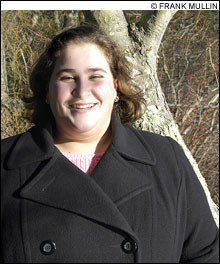A few months ago, for Jenna Broccolo’s 15th birthday, she and her family took a trip to New York City to attend a festival in Little Italy. Jenna, a sophomore at Westerly High School, asked her mom for one more gift: a full-length mirror. “You go, girl!” said her mom, Ann Marie Broccolo. “We’ll hang them all over your room!” It all started last May, when Jenna went for a routine visit to the doctor. She had always been substantially overweight, but when she stepped on the scale at the doctor’s office, the result surprised her. “She said, ‘Mom, if I go over 300, I’m in trouble,’ ” recalls Ann Marie. “She had eight pounds to go.”
At 5’1” and 292 pounds, Jenna was among the 16 percent of Americans between six and 19 who are considered overweight, an amount that has more than tripled since 1980, according to the federal Centers for Disease Control and Prevention (CDC). This increase, of course, has hardly been restricted to children. The National Center for Health Statistics reports that an estimated 65 percent of US adults are either overweight or obese, a 16 percent increase over the past 10 years.

Three factors — diet, physical activity, and genetics — are widely recognized as the main influences in the obesity explosion, although the relative significance of each remains a matter of some debate. Regardless, some of the driving forces are clear: according to Eric Schlosser’s Fast Food Nation (Harper Perennial, 2002), Americans spent about $110 billon on fast food in 2000, up from $6 billion in 1970. Snacks and packaged junk food are also more readily available to young people in schools and other locations, and adults have access to far more food and live far more sedentary lifestyles than in the past.
Although being thin remains the predominant beauty ideal for women, there are some glimmers of a larger cultural shift. As the New York Times reported last month, Kraft and PepsiCo have created rating systems to mark healthier foods, and Disney says it will remove characters like Mickey Mouse and Winnie the Pooh from food products it considers unhealthy for children. Dove soap launched a “Campaign for Real Beauty,” using “real” average-sized women as models. Disguising herself in a fat-suit, uber-model Tyra Banks recently bitched out men caught on hidden camera for judging her for her XL-size, and overweight Americans striving to shed pounds are transformed into empathetic figures on NBC’s The Biggest Loser.
Still, the US epidemic of obesity seems unlikely to fade away anytime soon, and it exacts a certain toll. The National Institutes of Health puts the economic impact of overweight and obese Americans at $117 billion, including treatment costs for obesity-related health problems like heart disease and diabetes, as well as dollars lost on productivity when people are sick with these conditions. As American waistlines continue to expand, scientists and public health officials are scrambling to counteract what many see as a leading health crisis. And because overweight adults usually start their lives as overweight children, figuring out how to prevent obesity before it starts has become something of a holy grail.
Being overweight isn’t just a health issue, however. It’s also a political issue, one tied up with body image, sexism, discrimination, and self-esteem. Nowhere is this more the case, as countless Americans reflexively focus their New Year’s resolutions on losing weight, than among adolescents, who are painfully aware of their own bodies, of their friends’ bodies, and of how they fit in (or don’t) among their peers.
A NEW MOVEMENT STRIKES BACK
The “fat movement,” born in 1969 with the establishment of the National Association to Advance Fat Acceptance (www.naafa.org), has finally come of age. In addition to NAAFA, there are nonprofits such as the Council on Size and Weight Discrimination, a “Health at Any Size” Web ring with 28 fat-positive sites, and an irreverent magazine called Fat!So? Marilyn Wann, editor of Fat!So?, asserts in an e-mail, “Weight-loss, as a goal, almost always does harm and almost never does any lasting good. The only reason otherwise sane people continue to pursue it is because of crushing social pressure.”
Some of the movement’s goals are political. These advocates want Americans to rethink their beauty ideals, to ask whether such concepts are being bought and sold by makeup (and soap) companies, fashion magazines, and the diet industry. Some of the goals are practical. NAAFA, for instance, has agitated against Southwest Airlines’ policy requiring especially large passengers to pay for two seats. Some of the goals are health-related. Up against the panicked consensus in the medical establishment that America has an epidemic on its hands, a small, but vocal contingent in the fat movement is arguing yes, there are more fat people than ever before, but there’s no reason to make such a fuss.